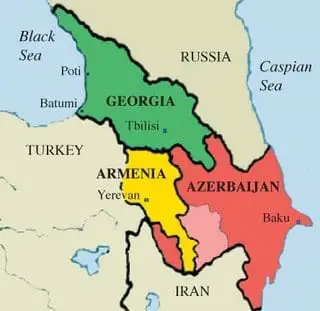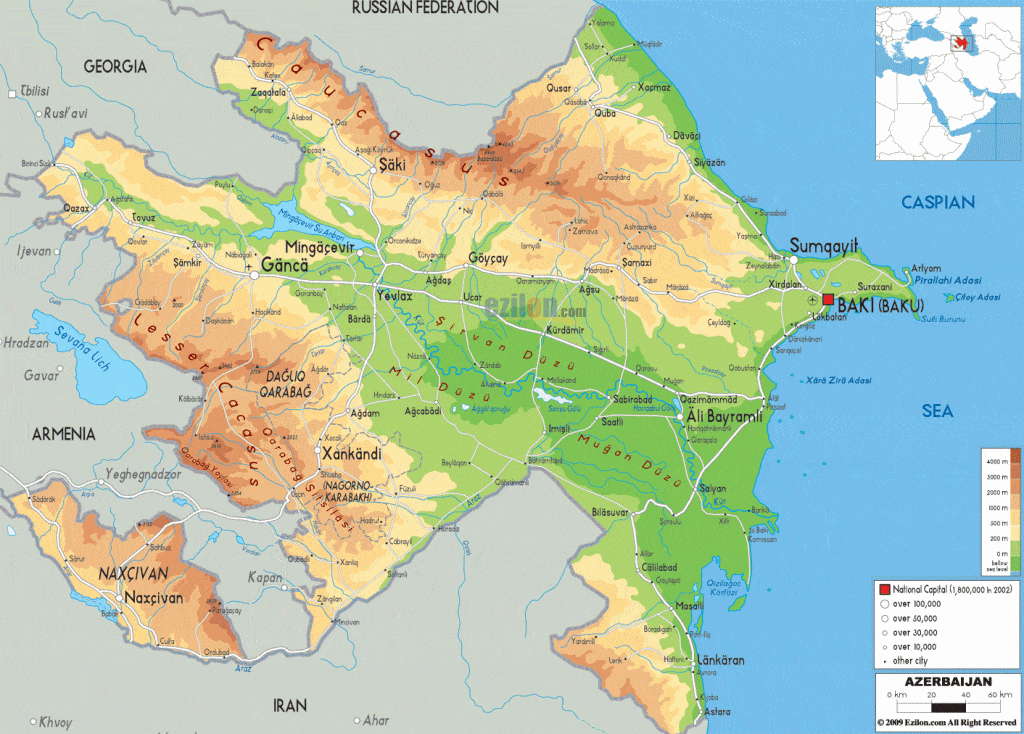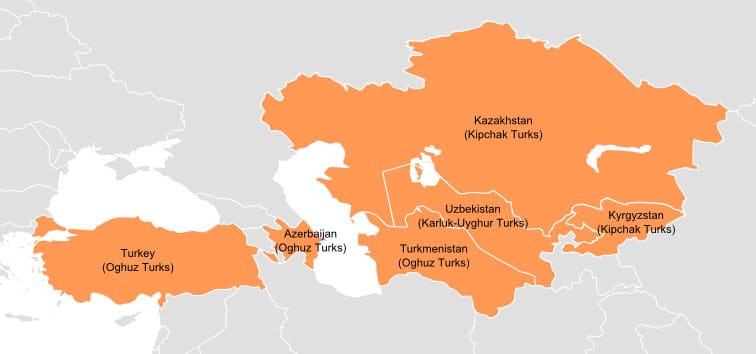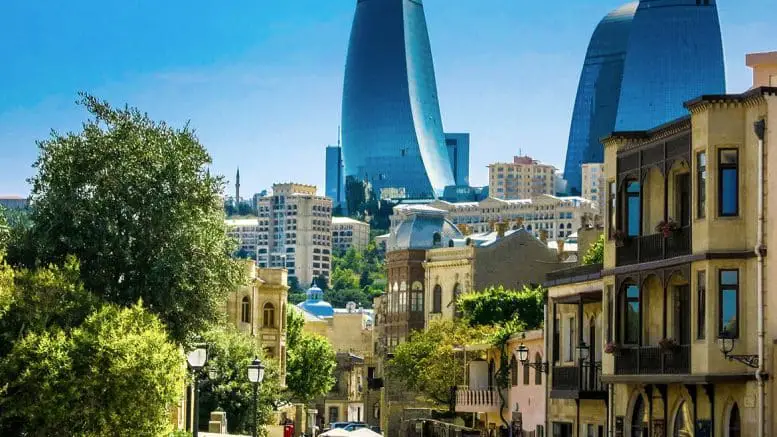Azerbaijan’s name comes from the Persian words, azer, which means “fire” and baygan, which means “protector.” The name was first applied in ancient times to the area around Baku, Azerbaijan’s current capital. Here, rich deposits of natural gas and oil resting close to the surface meant that, in places, the soil was actually flammable. A temple was built to honor what the people considered to be the powerful forces at play and many came on pilgrimages to see the wonders the site offered.
Kingdoms rose and fell throughout the centuries as competing empires and cultures vied for dominance and influence. The current country, its people, language, religion, and culture are the result of a long evolution that reflects that history. Finally gaining independence in 1991, the young nation was immediately faced with immense hurdles, economic and territorial, that continue to affect its foreign and domestic politics.
Introduction to Azerbaijan: Geohistory

Azerbaijan and its neighbors. Nagorno-Karabakh is shown in pink. For more on the Nagorno-Karabakh conflict, click here.
The Caucasus Mountains are a high and rugged range that ends abruptly at the Caspian and Black Sea shores. Azerbaijan, on the Caspian end of this range, has drastic elevation changes that allow its climate to range from chilly alpine at its peaks to subtropical at the coasts, all in a space about the size of the US state of South Carolina. Azerbaijan has long taken advantage of this climate diversity to grow an array of crops that today range from tobacco and cotton to vegetables and citrus fruits to grains and grapes.
Mountain ranges ring the nation and the Kura River runs through the country’s central plains and southeastern lowlands. Thus, central Azerbaijan is home to most of the nation’s arable farmland, of which it has a comparative bounty, but which is fed by a dearth of water resources when compared to other Caucuses nations. Further, poorly planned Soviet irrigation projects, meant to push the soil to greater productivity, led to erosion and high soil salinity.
Baku, Azerbaijan’s capital, lies in its extreme east, filling the natural hook of the Absheron Peninsula that spikes prominently into the Caspian. This shape makes Baku one of the Caspian’s best natural ports and Azerbaijan has long drawn strategic military and economic advantage from this. Baku and its metropolitan area are home to over 2.3 million residents – one quarter of the country’s population. Much of Azerbaijan’s extensive oil and natural gas production is located on and around the peninsula with additional major points dotting the Kura River.

Another 6% of Azerbaijan’s territory lies in the exclave of Nakhchivan. Although productive in agriculture and relatively rich in minerals, Nakhchivan is isolated from Azerbaijan by mountainous Armenian territory. Given the current conflict, transport between the exclave and the mainland is difficult and several mines are closed as the processing facilities that once served them are now inaccessible. Some Armenian nationalists claim that Nakhchivan is part of historical Armenia and should be reclaimed. Today, however, more than 99% of the exclave’s population is now Azerbaijani.
Azerbaijan from Pre-history to the Early 1800s
The Azerbaijani people are descended from the Caucasian Albanians. The Albanians were, along with Armenia and Georgia, once a third great Christian kingdom located in the Caucuses. However, in the great clashes between the Romans, Persians, Arabs, and Turks, the Albanians, unlike the Armenians and Georgians, were subsumed into other cultures.
This was a long process that took several centuries. While some splinter groups of Albanians merged into the Armenian and Georgian cultures, much of what had been Albania adopted Islam under the Arabs ca. 700-800 AD, a Persian language under the Persians (which became known as “Old Azeri”) by about 1100, and, beginning in the 12th century, would become “Azerbaijani Turks” when the Oghuz Turks began arriving in large numbers from Turkmenistan, on the other side of the Caspian, as part of the Mongol migrations. These same Oghuz Turks would settle as far West as the Anatolian peninsula, founding the Turkic culture of modern day Turkey. Through this evolution, the modern Azerbaijani language and culture (which are Turkic) emerged in the 16th century.

A topographical map of Azerbaijan, showing the high mountains, deep valleys, and relatively small rivers. Map from ezilon.
In the early 16th century, the area of modern Azerbaijan was ruled by the Safavids, a Persian dynasty that originated in a Shiite religious order known as Safaviyya, named for its charismatic leader, Safi ad-Din. Safaviyya was founded in Azerbaijan. Its leaders were Kurdish and Azerbaijani. Further, Azerbaijani was an important language of religion and culture throughout the empire, although Persian remained the dominant state language. The Safavids made Shiite Islam their state religion and converted the Azerbaijanis and Iranians away from Sunnism, which is still the dominant branch of Islam among Azerbaijan’s neighbors.
The Safavids eventually crumbled under external and internal pressures. The Ottomans and Uzbeks had long been foreign threats to the west and east, and they were now joined by the Russians who began pressing into Persian possessions in the North Caucuses. In addition, the Dutch East India Company pressed Persia out of its traditional and lucrative trade routes to Africa and the Middle East. Ethnic and religious tensions were also at play as Safavid deportations of ethnic Georgians left parts of its Caucuses holdings depopulated and Safavid attempts to forcibly convert Sunni Afghans eventually led to an insurrection that led to the final destruction of the dynasty in 1736.
Although the empire was largely maintained under the Afshar and Zand Persian Dynasties, these were both short-lived and the northern territories, including the territory of modern day Azerbaijan, came to be de-facto ruled by increasingly independent Turkic khanates or tribes.

Azerbaijan (red) lies between Turkey and Turkmenistan, two other Turkic countries. To the south lies the Middle East, which also contributed greatly to Azerbaijan’s history.
The Qajars then came to power in Persia in 1789. The Qajars were an Azerbaijani people that had played a central role under the Safavids. They raised the importance of the Azerbaijani language and culture within their new government and seemed poised to consolidate and strengthen the country. However, present-day Azerbaijan was annexed away from the Qajars by the Russians in 1813-1828, shortly after the Qajars came to power. The Qajars themselves fell in 1925 under pressure from old enemies and from political divisions that formed as the government tried to reform and rebuild its institutions to function in a more modern, international world.
Azerbaijan under the Russian Empire
As the local khanates began exercising more sovereignty, the Georgian Kingdoms of Kartli-Kakheti and Imereti, which at the time covered most of the central northern Caucuses, declared independence from Persia and became Russian protectorates in 1783. The Qajars, however, were set on rebuilding the empire and re-subjugated the Georgians in a bloody battle in 1795.
Russia wanted to maintain influence in the region, however, which they saw as a strategic launching pad from which to attack and defend against the Ottomans and Persians. Thus, in the early 1800s, a series of conflicts broke out between Russia and Persia. Russia, largely through better armaments and tactics, defeated the Persians in almost every battle and, by 1828, the Russians came to dominate nearly all of the Northern and Southern Caucuses.
The Tsar allowed the local khanates in Azerbaijan a considerable deal of autonomy until the 1870s, when Azerbiajan’s massive oil reserves were developed. Baku, where most of those reserves are, saw its population grow rapidly from 10,000 to about 250,000 as immigrants flocked to the city to work at the refineries and transit facilities. Western tycoons, such as the Rothschilds and Nobels, were invited to use Azerbaijan as a proving ground for their latest oil technologies. Baku became the terminus of the world’s first oil pipeline. The Nobel family ordered construction of the Zoroaster, the world’s first oil tanker, to carry black gold from Azerbaijan’s rich wells.
The Trans Caucasus Railroad was begun in 1865 in Poti on the Black Sea and reached Baku in 1883. The rails ensured that Russian troops could move swiftly through the rugged mountains should they be needed to defend against external or internal threats. The railroad also allowed Russia to develop the Caucasus regions economically and became another important route for transporting Baku’s oil west.
This rapid development created massive disparities between the mainly Christian, European rulers and tycoons and the mainly Muslim populace. The radical political movements of the early 20th century swept the new, impoverished urban centers. The tsarist government, to redirect aggression away from Russia, stepped up efforts to play various groups off each other, particularly the Muslim Azerbaijanis and Christian Armenians, who both claimed that the other had oppressed them in their long and intertwined histories. Thus, the revolutions of 1905 and 1917 saw the Azeris and Armenians fighting the Russians, the capitalists, and themselves.
A short report by CNN on Azerbaijan’s oil.
With the Russian civil war, Armenia and Azerbaijan briefly became independent, and immediately went to war with each other over disputed territory including Karabakh and Nakhchivan. Because both peoples had lived under larger empires for centuries, there were no clear borders between their communities. Some claims were based on uniting ethnic enclaves while some were purely historical, based on past borders of empires and kingdoms. The fighting was only ended when, in 1920, the Soviets invaded and brought both Azerbaijan and Armenia under Soviet control.
Soviet Azerbaijan
Azerbaijan was originally grouped with Armenia and Georgia in the Transcaucasian SFSR. This was broken into three pieces after it rapidly became clear that the three groups could not work together. Azerbaijan was initially a strategically important part of the USSR, providing the 60% of the country’s oil production. Azerbaijan received heavy capital investments from the Soviet government to develop new fields and support agriculture. For a time, Azerbaijan was also the USSR’s top tea producer.
Fighting in WWII never reached Azerbaijan, but its strategic energy importance meant that the Nazis prioritized taking the republic, as much as to cut off the Soviet’s ability to fight as to fuel Germany’s own war effort. The Nazis were stopped at Stalingrad, where mankind’s bloodiest single battle in history was fought. In large part, this battle was over the oil in Azerbaijan.
In 1941, at the start of hostilities, the USSR invaded Northern Iran, where Azerbaijanis had held an ethnic majority since Persian times. This gave rise to the possibility that the two populations of Azerbaijanis might be united within a single border for the first time since the Russo-Persian wars of the 1800s. However, soon after the war ended, the USSR was pressured by the other Allies to abandon the Iranian territory. The episode boosted Azerbaijani nationalism both inside and outside the USSR.

The 1980s and Glastnost brought more economic problems to Azerbaijan as the Soviet economy and political system crumbled. Heidar Aliyev initially resisted the reforms and was forced out of politics by the Gorbachev administration. As economic problems mounted, so did ethnic tensions as Armenia pushed to be given Nagorno-Karabach, an Armenian-majority region in Azerbaijan. Moscow’s indecisive action helped lead more Azerbaijanis into opposition as tensions over Nargorno-Karabach escalated into physical confrontations, riots, and, after both Azerbaijan and Armenia declared independence, war.
Post-Soviet Azerbaijan: Lingering Issues
The Nagorno-Karabach War lasted six years. Azerbaijan’s military was ill prepared, having more soldiers but less equipment and fewer trained officers than Armenia. By 1994, Azerbaijan had lost control of Karabach and an additional 10 percent of their territory. The ceasefire declared that year, the Bishkek Protocol, gave Azerbaijan sovereignty over the area, but also wide autonomy to the disputed territories. However, the Protocol was never fully implemented and Nagorno-Karabach still declares itself to be an autonomous republic, although it is unrecognized by the international community. Thus, the conflict was frozen in 1994, and although the OSCE Minsk Group was created for to find an amicable solution to the lingering conflict, no long-term solution has been found.
Nagorno-Karabach continues to have major implications for Azerbaijan. Internally, the war left close to 10 percent of the population displaced, many living in dismal huts and railroad cars, unable to return to their homes, creating humanitarian and economic issues. With war and rising nationalism in Azerbaijan’s early years of independence, most of its minorities, which once included Russians and Armenians numbering about a half million each, left the country. Today, Azerbaijan is 92% ethnically Azerbaijani.
Azerbaijan’s first president, the former Soviet leader Ayaz Mutalibov, was voted out of office in 1992 in large part by an electorate unhappy with the results of the war. He was replaced by Abulfaz Elchibey, a former Soviet dissident and a pro-western, economic liberal. However, claiming mismanagement and corruption in the continued efforts to secure Nagorno-Karabach, the Azerbaijani military eventually turned on Elchibey and displaced him in coup, bringing back former Soviet leader Heidar Aliyev, then 70.
A short video from Stratfor on Azerbaijan’s current geopolitical position.
Aliyev quickly consolidated power by first meeting popular demands. He froze the conflict by signing the Bishkek Accords, ending the fighting. He also signed the “Contract of the Century” with a consortium of 11 major international oil companies to develop the large offshore hydrocarbon reserves Azerbaijan holds in the Caspian. Pipelines linking Azerbaijan with Russia, Georgia, and Turkey were built or refurbished in the late 90s and early 2000s. Billions of dollars in new energy revenue followed into Baku, complimented with successful economic reforms and a major privatization program. Aliyev’s critics also point to the jailing of political rivals and the stifling of dissent as other ways power was consolidated.
Much of Azerbaijan’s foreign policy has also been heavily influenced by the Nagorno-Karabach conflict. Maintaining close relations with Turkey, which is close to Azerbaijan in culture and language, as proved essential to maintaining an economic blockade against Armenia. Azerbaijan has also carefully balanced relations between Russia and the West to maximize support for the continued recognition of Nagorno-Karabach as Azerbaijani territory as well as to secure markets to sell oil and natural gas and to buy weapons.
With the Armenian border closed, Azerbaijan’s main route to the Nakhchivan enclave lies through Iran. Iranian-Azerbaijani relations are complicated, however. Most pressing is the fact that Iran claims Caspian maritime territory currently recognized as Azerbaijani. This stretch of sea contains a major, undeveloped hydrocarbon deposit. Although violence has not yet occurred, the Iranian navy has kept Azerbaijani engineers from exploring the deposit.
Other major issues are also affecting relations. Some 20-30% of Iran’s population is Azerbaijani, concentrated around Azerbaijani border. Azerbaijani nationalists on both sides of that border dream of reuniting the population under a single flag. Azerbaijan has also supported sanctions against Iran, in what critics call a diplomatic maneuver to gain US favor. Although both countries are overwhelmingly Shiite and surrounded by Sunni-dominated countries, Azerbaijan’s liberal Muslim community differs strongly from conservative Iran’s. Thus, despite a long shared history, the two countries often find themselves at odds. These relations may change, however, as US-Iranian relations warm, this may allow Azerbaijani-Iranian relations to also improve. However, if the Nargorno-Karabach conflict is solved, this might lead Azerbaijan to take a harder stance against Iran and perhaps even advance territorial claims to Northern Iran to counter Iranian claims in the Caspian.
Modern Azerbaijan
In 2003, Heydar Aliyev stepped down from the presidency at the age of 80. He had suffered a collapse on live television and died that same year. He was succeeded by his son, Ilham Aliyev, in an election in which international observers cited violence and vote rigging. Critics say that oppression, corruption, and electoral fraud remain widespread and that oligarchs are now the real source of political power. Reporters without Borders cites common instances of harassment or arbitrary detention for journalists in Azerbaijan.

The Aliyevs, Heidar (right) and his son Ilham (left), have ruled Azerbaijan since 1993.
The Aliyev regime, however, is not without supporters. Ilhman Aliyev has largely continued his father’s domestic and foreign policies. While Nagorno-Karabach has remained disputed territory, fighting has been limited to brief border incidents. The conflict itself has become a source of nationalism that the government has tapped. Economically, GDP has increased nearly 10-fold since 2003 according to the World Bank. While economic development has been uneven and poverty remains a major issue, the overall economic situation has substantially improved.
The regime face approaching economic problems, however. Crude petroleum accounts for some 88 percent of the nation’s exports. With falling oil prices, GDP will fall as will government spending as revenues subside. Baku is thus pushing for economic diversification. Information technology is being developed and the tourism industry has been advertised in international mass media. Shipping and transportation is being supported, as the state hopes to grow as a hub between Europe, the Middle East, and Asia. Citing food security issues, the government is supporting agriculture, moving production from soil-intensive cash crops towards basic grains and produce. This may help stabilize food inflation, a common source of public discontent, as the nation’s oil-dependent currency falls in value and imports become more expensive.
Azerbaijan’s history and location have given it many advantages and many problems. Its strategic position on the hydrocarbon rich Caspian, between Asia, Europe, and the Middle East are economic boons. Its turbulent history has given it a unique culture but also security issues on and within its borders. Its current political system has made friends at home and abroad, but also drawn criticism for many of its strong-handed policies implemented in the name of bringing stability to the young country. Thus, moving forward, there are many reasons to hope that Azerbaijan’s future will be bright, and many reasons to hope for continued improvement for the sake of the prosperity and freedom of the Azerbaijani people.


